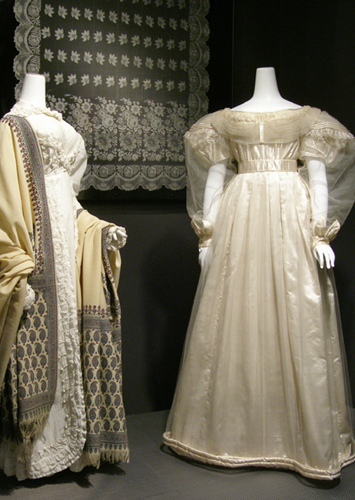 |
|
LEFT:
Spencer jacket and skirt
White cotton
Circa 1819, England
The Museum at FIT, P88.28.2, Museum purchase
Shawl
Wool and silk
Circa 1835, possibly Scotland
The Museum at FIT, P86.71.2, Museum purchase
MIDDLE:
Apron
Ivory silk gauze
Circa 1820, France or England
The Museum at FIT, 2007.12.3, Museum purchase
RIGHT:
Dress
Cream silk satin, tulle, chiffon
Circa 1830, Russia
The Museum at FIT, 2007.12.4, Museum purchase
| |
Pure white, cotton
dresses and novelties were subtle expressions of luxury in the early
19th-century. They were also a response to the simplicity and
“democratic” ideals promoted by Jean-Jacques Rousseau and other
Enlightenment philosophers.
Kashmir shawls from India were a luxury in Europe. Demand for these
light, smooth shawls spurred European weavers to produce their own
versions.
Expensive-looking, delicate, and ornamental, accessories
played an important role in the construction of fashionable
femininity in the 19th century. Unlike most aprons, which were
highly functional, this delicate, silk gauze apron was designed to
be purely decorative.
This exceptionally beautiful dress belonged to Empress Alexandra
Feodorovna (1798-1860), wife of Emperor Nikoli I of Russia. Russian
aristocrats were traditionally great patrons of the couture, a role
now often assumed by the new Russian billionaires. | |